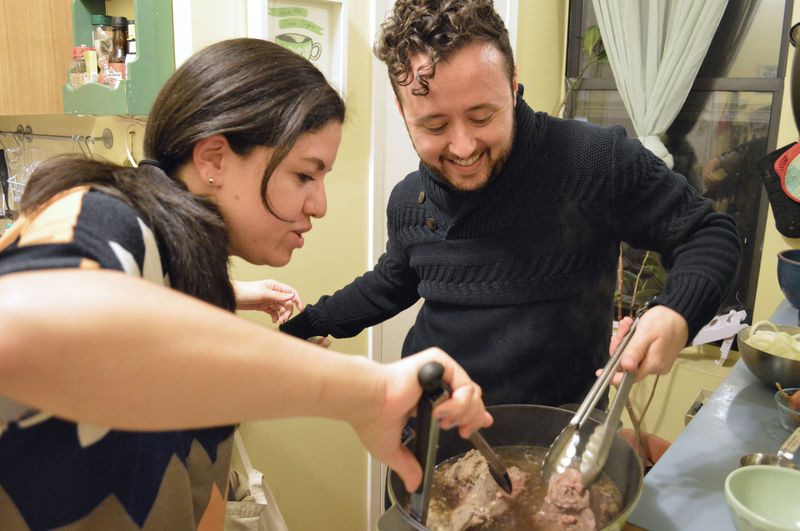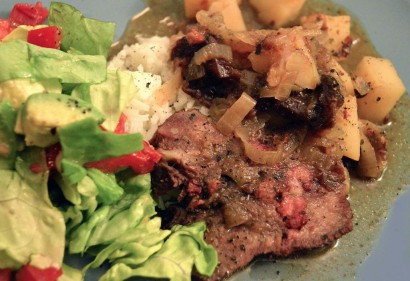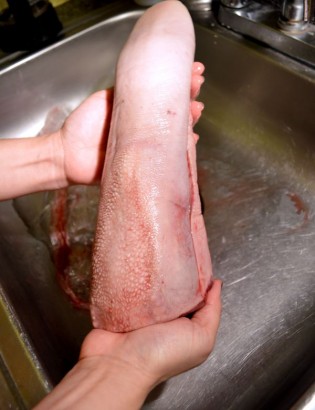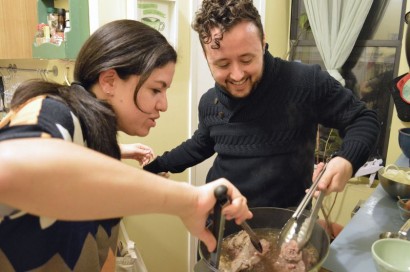The latest installment in Von Diaz’s culinary odyssey as she cooks and blogs her way through the iconic Puerto Rican cookbook, Cocina Criolla as part of our Food in 2 Worlds™ series. Read her earlier story on making surullitos.
Lengua Estofada from Von Diaz on Vimeo.
Tongue? Seriously?
It’s hard to think about cooking an entire beef tongue no matter how trendy it may be to “use the whole animal.”
When I lived in the San Francisco Bay Area I discovered tacos de lengua at Taqueria Cancun in the Mission District. I ate them at least once a week, enjoying their texture – delightfully spongy yet crisped around the edges, with an earthy, gamey flavor. I’ve continued to enjoyed lengua tacos in El Barrio, the neighborhood where I now live in New York.
I had never actually made beef tongue. I hadn’t even watched it being prepared. But Chef Carmen Valldejuli’s recipe for lengua estofada, or stuffed beef tongue, seemed a fitting way to continue to learn from her authoritative book on Puerto Rican cooking, Cocina Criolla, and experiment with something I knew I loved.
I took to the streets to find a tongue.
My first stop was the Casablanca Meat Market, a fabulous Latino butcher on 110th street that has a front window filled with gigantic slabs of chicharron, comically big, as if made from a whole side of pig. But it was Sunday, a day when stores still close in this neighborhood. So I did what any other New Yorker would do, I searched on Yelp for the closest open butcher shop.
El Barrio’s Mexican population has been growing, leading locals to call certain blocks “Little Puebla” after the Mexican state. At Lexington Avenue and 103rd St, a block that still boasts a Puerto Rican cultural center and a huge mural representing 1960s Puerto Rican East Harlem, the street is flanked on one side by a burrito joint and a Mexican grocery store, and on the other side by a gourmet Mexican restaurant and an upscale taco shop. Nearby there’s a new bookstore named La Casa Azul after artist Frida Kahlo’s childhood home.
The Little Mexico Meat Market came up first, and my Mexico-to-Puerto Rico tongue connection came full circle. Hanging from the ceiling were streams of papel picada, or colored paper streamers and piñatas, and the entryway was full of baskets of dried chiles, cacahuazintle, and beans. And there it was – my beef tongue in the glass case, longer and thicker than my forearm and wrapped in plastic. I also purchased jamón de cocinar, or cooking ham, for the stuffing, and left the store delighted with my purchase.
Cocina Criolla is full of scary meats, and lengua is certainly one of them. When I came home and unwrapped the tongue from the protective plastic, I was speechless. It looked like an alien creature, and just too much like … a tongue. Somehow meat is harder to work with, at least for me as a former vegetarian, when it’s an identifiable part of an animal. I also wasn’t prepared for the way it felt—very solid, and similar to a rubber tire covered in tiny hairs like those on a cat’s tongue.
When I was growing up in Atlanta we never ate tongue, even though it’s common Puerto Rican fare, because my mother thinks it’s gross. She would tell the story of coming home from school – I imagine her in her burgundy Catholic school uniform – going into the kitchen to get a snack, and shrieking at the sight of a giant cow tongue plopped in the kitchen sink.
I, too, had issues almost immediately. Usually in a tongue taco, the meat is finely chopped and served on a corn tortilla with the usual toppings—a far cry from making a whole tongue as an entree.
The first step was to boil the tongue for 30 minutes in a tightly lidded pot to loosen the skin. But I think Chef Carmen got it wrong. I watched YouTube (that’s right “real” chefs, learn to cook from YouTube) to get advice on how to prep and handle the tongue. The preparations varied wildly, but none resembled Chef Carmen’s instructions. Some videos involved pressure cookers, while others recommended cooking the tongue for a full 4 hours before peeling.
Chef Carmen’s technique did not loosen the skin at all, making me wish I’d peeled it before because now it was tough and hot. Boiling made the tongue look even more alien. The skin turned a kind of ecru color and the muscle tensed, making the tip turn up in a very tongue-like manner. I ended up trimming the skin with a sharp knife rather than peeling it. Once the skin was off I was surprised by how much tongue looks suspiciously like beef. It does have some bizarre fat pockets and other crevices, but otherwise it’s just red meat.
Next, I had to adobar or season the tongue the way you would prepare a pernil or pork roast or any other beef roast. Making more than a dozen deep cuts all over the tongue with a slender blade, I stuffed the holes with a typical adobo (garlic, oregano, olive oil, vinegar, salt), but with added jamón de cocinar (ham steak is a reasonable substitute). The recipe also calls for tocino, or salt pork, but I just couldn’t bring myself to stuff the tongue with chunks of fat. I have my limits.
This final step marked the end of the tongue-handling trauma, and the rest was simmering and waiting. The recipe called for an obscene amount of thinly sliced white onions, a great excuse to pull out the mandolin that’s been collecting dust in our already crowded kitchen. Other than that, the ingredients were standard, with potatoes added towards the end.
Sneakily, I invited a group of unsuspecting friends to partake in the tongue-lashing, I mean, tasting. When I announced the main dish the color drained from their faces, and one friend looked a little nauseous, but they are all foodie thrill-seekers and were up to the challenge.
Once it was done cooking, I removed the tongue from the pot with tongs and let it rest on a cutting board before slicing. The once alien creature actually looked appetizing and smelled delicious, like pot roast. I served the sliced tongue over rice with the sauce from the pot, boiled potatoes, and a simple salad of butter lettuce, avocado and tomato. Everyone cleaned their plates, and, in the end, the tongue made for great dinner conversation.
I would call the lengua experiment a success, but I’m not making it again. One of my diner guests said it best – It’s like a pot roast, but maybe not as good and three times the work. Plus the sauce needed a lot of adjusting because it was way too sweet, so I added capers, olives, and a little lemon juice to mellow it out.
A couple more valuable lessons on my path to Cocina Criolla enlightenment:
- Chef Carmen leaves some things out. Trust your instincts, and YouTube.
- Do your East Harlem meat shopping on Saturdays.
From now on I think I’ll stick to tongue tacos.
Lengua Estofada
This recipe has been adjusted to better describe the tongue preparation process, and to account for the overly sweet sauce. Capers, olives, and lemon juice are not in the original recipe.
Serves 6
1 2½-3 lb beef tongue
Adobo and Stuffing
2 garlic cloves, minced
1 tsp dried oregano
2 tsp salt
1 tsp olive oil
1 tsp white vinegar
Fresh ground black pepper (to taste)
2 ounces jamón de cocinar (cooking ham), finely chopped
1 ounce tocino (salt pork or pork cheek), finely chopped (optional)
Braising Ingredients
4 large onions, sliced in rounds
12 prunes
½ cup white wine
2 bay leaves
¼ cup sugar (optional)
Finishing
2 lbs of potatoes, peeled and cut into 1½ inch cubes
12 pimento stuffed green olives
1 tbsp capers
1-2 tsp fresh squeezed lemon juice
- Wash the tongue, then boil in 4 quarts of salted water for ½ hour, covered. Remove from water, drain, and let cool.
- Peel away the “capa dura” or thick exterior skin with a sharp paring knife.
- Make a dozen or so deep holes along the sides and center of the tongue with a narrow, sharp knife.
- Mix the stuffing ingredients together in a bowl. Fill the slits in the beef tongue with the stuffing.
- Put the tongue in a heavy stockpot or Dutch oven. Add 1½ quarts of water and 1 tsp of salt. Bring to a boil, then reduce the heat to low, cover, and cook for 3 hours – flipping the tongue once halfway through.
- Add braising ingredients and stir to combine. Return lid to pot, and cook 1 more hour.
- Add the potatoes, and simmer uncovered for 30 minutes, until the potatoes are cooked through. Add olives, capers, and lemon juice. Salt and pepper to taste.
- Remove tongue from the pot with tongs and let rest on a cutting board for at least 5 minutes. Slice into rounds and serve over white rice with boiled potatoes and sauce.
Fi2W is supported by the David and Katherine Moore Family Foundation and the Ralph E. Odgen Foundation.







